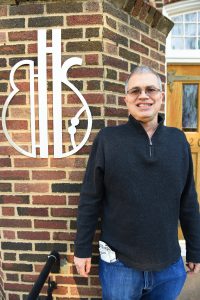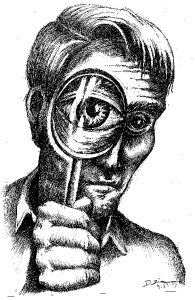There are issues that drive me crazy, truly. I try not to give in to them, I look away and look for more interesting activities, but eventually, sooner or later, they come back to me. I am thinking mainly about how pavements are treated.
Once the NOT office building, commonly known as the Szkieletor, today the Unity Tower, a skyscraper in the Krakow district of Grzegórzki, at Lubomirskiego Street 20, next to the Mogilskie roundabout. It is the tallest building in the Unity Center office complex under construction. Big complexes get everyone's attention, smaller ones are ignored.
We are all pedestrians—some more often, some less, but everyone moves on foot from time to time. What's more, all children are are—almost by definition—pedestrians, so is the vast majority of seniors, and also many people with various types of disabilities move around this way. Therefore, a pedestrian is the weakest participant in traffic. And yet we are treated as an addition to streets and cars, as a annoying obstacle and not a central element of the traffic organization.
First-hand example. One of the streets in the area where I live has been invaded by developers for several years, who build new blocks there. The street is a remnant of a village near Krakow and it is also as wide—two horse carts (I say this without irony) would pass each other without any problems. Unless they were carrying sheaves from the field, then there could be a problem. And this very street, where there is also a large primary school, has no sidewalks. Pedestrian traffic is sort of "run for your life" experience when people have to run away from oncoming cars to the leaky, wet roadsides.
The two newest construction sites, however, made some effort—perhaps forced by the City Hall—and built several meters long sections of the pavement adjacent to their lots. Today I know that maybe it would be better if they didn't. The newer one ended "its" section on one side with a switch-gear, and on the other with a tree. In addition, customers from the stores from on opposite side of the street park their cars there all the time.
I said that it would be better if these sidewalks were not there because nobody had parked there before and it was difficult, but possible to walk through there somehow. Now, especially with some snow cover, it was impossible even for me, a quite a fit man. To my expressive hands movements, the unfazed drivers replied "you are right, there is a lot of snow... ."
On the left a switch-gear, and on the right a tree—enveloping this short section of the pavement. As you can see, the cars have found a new parking lot.
And they park there, because the parking lot in front of the block, where there are shops of two "close-to-home" chains, is even an even more evident middle finger shown to both residents and officials. The first stage of screwing us was the fact that three lanes were built along the block: a detour for cars, then a sidewalk and finally a parking lot for residents. And now the pavement was 100 cm wide, and the parking lot was so small that from the first day after it was finished, all cars were parked with their backs in the parking lot, and fronts on this pseudo-pavement. Let me remind you, there was no sidewalk on the other side of the street at all back then.
After some time—a year, maybe two—that pavement was, brace yourself, narrowed. It turned out that someone demanded that the law be respected, i.e. that cars should not be placed on it. After the correction of this state of affairs, the former pseudo-pavement, was narrowed to 50 cm. And now everyone can park on it at will, because it is not a pavement anymore. So now we have about 30 meters of street with sidewalks on both sides which are not considered pavements neither by pedestrians nor drivers and are just dangerous.
This strip in the center is a former sidewalk, today part of a parking lot.
What I am talking about are—on a city scale—small things. However, it is just that such "little things" that are closest to us that hurt the most. So it is not surprising that in a "well-tempered city," to recall the title of the Jonathan F.P. Rose's book, it all starts with additives, small things, details that are closest to us and make us feel safe and—sometimes—happy. It may be surprising, but it the audio world is not that much different in this respect.
We start building a system for listening to music from the "main" products: loudspeakers, an amplifier, and a signal source. And that's okay, it's normal, although with time I think more and more often that everything should start with the speakers and the room, because their correct interaction is a guarantee of success, and a mismatch leads to failure. But OK, lets start with one of the three basic components of an audio system.
Cables are usually the next step. Again, it's good, very good, although I personally treat them on a par with the other three. When we have "mastered" these elements, we start to wonder what to put these devices on, how to protect them against vibrations, and then how to fight noise in the system. This way, we can build a harmonious, mutually supportive set of products that can actually be called a system. And this is one of the elements that introduce us to the actual topic of this article.
This was the Finite Elemente Master Reference Pagode Edition rack, the base—literally and figuratively—of my system, in the form in which it was brought to me a few years ago.
The last of the points I have mentioned seems to be irrelevant, additional, and redundant even for the vast majority of people who are not satisfied with the noise by the majority of the society of any country, confused with music. Let me tell you a simple truth, which we repeat every now and then, and which we usually don't believe: everything contributes to the sound in an audio system. This is one of the most important rules worth remembering and sticking to. Those who think otherwise don't know what they're saying.
Therefore, anti-vibration bases, whether they are platforms or racks, or finally—feet, are the inalienable "right" of our system. And it is these elements that make it really alive. I have witness it in my own case. I come from the sound industry, pro community, so I denied such ideas for a long time. Until for the first, second, third and tenth time I ran a self-test that proved me wrong. Based on these observations, I changed my mind and started to pay more and more attention to this element of the audio system, even though it is not always visible.
Like everyone else, I started with the loudspeaker platforms; marble ones. It worked well, but—I think—because of the imperfection of the loudspeakers and the entire system, and not because of any exceptional "healing" properties. When I finally mastered the sound of my system, it turned out that I had to replace them, that they are not enough anymore. Today, under the Harbeth M40.1 loudspeakers, I have custom-made stands prepared by the owner of the Acoustic Revive company, which cost the same as the loudspeakers themselves (more HERE). When I say it, people don't want to believe it, because the stands are just an "accessory."
The speakers' stands were filled with a mixture of three materials developed by Mr. Ishiguro, the owner of the AR.
Initially, some solutions did not appeal to me and I did not use rock crystal discs, which are here the interface between the speakers and stands. I also unscrewed the feet of the stands, placing them on discs made of rock crystal, though prepared by a different company. That is why I wrote then that I would not stick the company's logos on the stands, because I considered this project unfinished. Today, the AR quart disc have returned to their place, along with the CP-4 washers from that company, and the feet are fantastic PABs ceramic 60 SN. Probably the next step will be to replace the platforms under the speakers, but finally I can say "I'm home." It only took me about five years.
Franc Audio Accessories feet under the Ayon Audio preamplifier - you can also see additional crystal discs and CP-4 washers.
The path I took with the bases for devices in my system was quite similar. There are Franc Audio Accessories Ceramic Disc Classic feet under the preamplifier, but instead of their upper aluminum plates I use—again—Acoustic Revive RIQ-5108 crystal discs, also here combined with the CP-4. The whole thing is placed on the company's RAF-48H pneumatic platform. It's quite a neat solution that works great in my professional life and fits well with the Finite Elemente rack.
I thought that Japanese platforms would stay with me forever, because although I was tempted by the phenomenal Stacore products, in my situation where I move and rearrange something every day, they were impractical. For the first time I was seriously thinking about the change only after I reviewed the Monument platform of the Polish company Thunder Melody. It offers everything that the RAF-48H does, but "more."
Thunder Melody Platform with the SACDCD-35 HF Edition player on it.
I could put all the elements of my system on them, if not for the price of such a set, the need to provide a separate grounding strip and their slightly higher profile than the current platforms. Because, as you probably well know, audio systems do not live on a desert island, but in a specific environment. For some it will be a home environment, for others an environment limited by something else, often simple matters. For me, it is about the height of the platforms—the Monument would not fit under the preamplifier or the power amplifier, and the player was a bit too high and blocked out the TV screen. Minor matters, but still crucial for making a decision.
So my first step, I think, is to replace the rack itself. I thought about it a lot, there are some very interesting proposals on the market, but I will probably decide on a newer model of the rack that I already have. Because if everything in the system is so harmonious, if I know the sound of the tested products reviewed while using the Mk I version so well, then a different choice would be a leap into the unknown. A Finite Elemente Master Reference Pagode Edition Mk II, that I think about, should meet all my requirements. Even more so considering that it will allow me to try out new carbon shelves.
Thanks to the Pro Audio Bono ceramic 60 SN feet under the Acoustic Revive platforms, I finally decided to stick the logos to the latter, recognizing that this closed a certain stage. It took me nine years!
In this way, the system grows and gains muscles, tendons and the body. From the project something emerges that is in a way alive, because it changes over time, and these changes bring a new quality to our lives. In addition to anti-vibration elements—and I did not even mention the cable supports and the platform under the power strip—there is also an artificial ground, Nordost devices that minimize noise in electronics, plugs for unused sockets, etc. And each of these elements is important each of them plays an important role in this living organism.
It may seem that not having them would not be a big deal, they are not the "main" components. Life teaches, however, that they offer a kind of complement, without which it is difficult to talk about a system, and at most about a set. Therefore, it is worth taking a closer look at how our system lives, it is worth taking a closer look at its development and supporting it, improving, or even just initiating its growth, stimulating its blood circulation, putting it together into one functioning whole. It is beautiful, that it can be done at any price level, because even an amplifier for 1000 zlotys powered by a good cable, placed on a good platform, weighted down with something from above, will sound much better than without these elements—simply will start to live.
Images: Wojciech Pacuła
















































